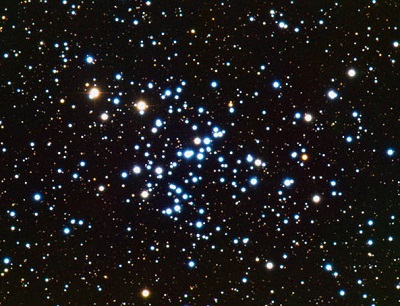Messier 93 is an open star cluster located in the constellation Puppis. It lies at a distance of 3,600 light years from Earth. The cluster has a dimension that is roughly two thirds the size of the full Moon.
| Description | |
| Visible From Pacific Northwest | November To March |
| Best Time To Observe | January |
| Minimum Size Of Viewing Device | Binoculars |
| Object Type | Open Cluster |
| Designations | Messier 93, M93, NGC 2447, Collinder 160, C 0742-237, OCl 649.0, MWSC 1324 |
| Right Ascension | 07h 44.6m |
| Declination | -23°52′ |
| Constellation | Puppis |
| Age | 100 Million Years |
| Apparent magnitude | +6.0 |
| Apparent dimensions | 22′ |
| Object Radius | 10-12 light years |
| Distance From Earth | 3,600 light years |
History
The cluster is one of Charles Messier’s original discoveries. The French astronomer found it on March 20, 1781 and subsequently added it to his catalogue of comet-like objects. He described his 93rd entry as a “cluster of small stars, without nebulosity, between the Greater Dog [Canis Major] and the prow of the ship [Puppis of Argo Navis]. (diameter 8′)”
The ship Messier was referring to is Argo Navis, represented by the Greek constellation Argo Navis, which has since been divided into three smaller ones – Vela, Puppis and Carina – each representing a part of the ship: the sails, the stern, and the keel and hull.
Caroline Herschel observed the cluster on February 26, 1783. It was the first deep sky object she added to her own catalogue.
Locating M93 In The Sky
Messier 93 is not very hard to find as it is located in the same area of the sky as Sirius, the brightest star in the sky. Located in Canis Major, Sirius can be found using the stars of Orion. A line drawn through the three bright stars of Orion’s Belt extended southward leads directly to the star. About 8 degrees to the southeast of Sirius are the two components of the Omicron Canis Majoris system: Omicron-1 and Omicron-2 CMa. A line connecting the stars extended to the east and a little south for about 10 degrees leads to M93, which lies near the magnitude 2.21 star Zeta Puppis. The best time of year to observe M93 is during the winter.

Viewing M93
M93 can be seen without binoculars under exceptionally clear, dark skies, and is easy to find with binoculars. It has an apparent magnitude of 6.0. Binoculars and small telescopes reveal the triangular shape formed by the cluster’s brightest stars. Small telescopes show a large, dense star cluster with a grouping of stars shaped like an arrowhead near the centre. 8-inch and larger telescopes resolve dozens of stars in the cluster.
Photographing M93
As Messier 93 can be tough to see with smaller gear from all but the darkest sites, using a larger scope to image will be helpful. Messier 93 is not necessarily the most popular object so finding great guides is not going to be easy. Accurate autoguiding and forums such as cloudy nights will be the best bet here. But having the gear and a larger telescope with autoguiding will get the job done
https://www.astrobin.com/374078/?nc=all
Sources And Further Reading
Descriptions of all of Messier Objects can be found here.

Be the first to comment on "Messier 93"